An Analysis of the Altitude Impact on Roots Compressor Operation for a Fuel Cell System
Abstract
1. Introduction
1.1. Knowledge Gaps
1.2. Contribution and Objectives
- Understand the matching between a roots compressor characteristic map and a fuel cell sized for a heavy-duty truck application;
- Evaluate the effect of the compressor operating conditions (pressure ratio and efficiency) on the compressor power consumption and balance-of-plant efficiency;
- Quantify the implications of altitude on the maximum achievable power and energy balance;
- Discuss the relationship between the compressor map and the altitude impact.
2. Materials and Methods
2.1. Balance-of-Plant Model
2.2. Compressor Selection and Modeling
2.3. Simulation Conditions
- Ambient temperature and pressure conditions are calculated as a function of altitude according to the international standard atmosphere, in a range between sea level (0 km) and 5 km.
- The air filter is assumed to produce a maximum pressure drop of 2% for the highest operational air mass flow (0.3 kg/s). For lower air mass flows, a linear decay of this pressure drop is assumed.
- The compressor reduced speed is controlled to achieve the target air mass flow for a constant oxygen excess ratio of 2.
- The compressor electrical power is adjusted to control its pressure ratio, in a range between 1.05 and 2.8, with a step size of 0.025. The inlet pressure at the fuel cell is assumed to be equal to the compressor outlet pressure for both cathode and anode streams.
- The temperature of cathode and anode gas streams, as well as the internal fuel cell stack temperature, is set at 73 °C in order to reach the maximum proton conductivity of the membrane.
- Relative humidity at both cathode and anode gas streams is set at 70%.
- The hydrogen excess ratio defined at the anode inlet is set at 1.5, with the hydrogen excess being used to calculate power consumption from the recirculation pump.
- The voltage in the fuel cell stack is limited to a minimum value of 0.6 V/cell in order to operate in the range covered during the validation phase and ensure that the stack does not reach oxygen-limited operation that could eventually lead to its degradation in real conditions.
3. Results
3.1. Sea-Level Analysis
3.2. Altitude Impact
4. Conclusions
- The pressure in the fuel cell stack helps to extend the current density operating range and therefore increase the achievable fuel cell power. However, the sensitivity to pressure starts reducing when the pressure exceeds 2 bar, where the minimum differences are achieved from 2.45 bar on.
- At sea-level operations, a minimum compressor power consumption is seen at low-to-mid fuel cell power (i.e., air mass flow) operations, which are dominated by the isentropic efficiency evolution. This minimum power increases nearly exponentially with the pressure ratio.
- At mid-to-high-power conditions, the Roots compressor efficiency is nearly constant and close to the highest efficiency, and the compressor power consumption is dominated by the air mass flow.
- As altitude increases, the maximum corrected air mass flow tends to increase as a consequence of the lower ambient pressure. However, thanks to the characteristics of the Roots compressor, it operates with minimal changes in efficiency (between 60 and 70%) for a wide range of altitude and mass flow conditions.
- For the highest altitude and power operating conditions, the combined increase in corrected mass flow and pressure ratio makes the compressor leave the best efficiency area, consequently increasing the power consumption and limiting the maximum balance-of-plant performance. Particularly, the peak net power produced is lowered from 200 kW at sea level to 135 kW at a 5 km altitude, which represents a 32.5% deterioration. Additionally, the balance-of-plant efficiency is also impaired, reaching up to a 7% reduction.
- At mid-to-low net power operations, the best efficiency values are reached for nearly constant (and low) pressure ratios, with a slight increase as a function of the altitude. Consequently, the fuel cell stack operating pressure is reduced, inducing a penalty in efficiency of up to 3%.
Author Contributions
Funding
Institutional Review Board Statement
Informed Consent Statement
Data Availability Statement
Conflicts of Interest
Abbreviations
| BOP | Balance of plant |
| CL | Catalyst layer |
| FC | Fuel cell |
| FCV | Fuel cell vehicle |
| GDL | Gas diffusion layer |
| M | Electric motor |
| OER | Oxygen excess ratio |
| P | Hydrogen recirculation pump |
| PEM | Proton-exchange membrane |
| PEMFC | Proton-exchange membrane fuel cell |
| pin,a | Anode inlet pressure |
| pin,c | Cathode inlet pressure |
| pr | Pressure ratio |
| Tin,a | Anode inlet temperature |
| Tin,c | Cathode inlet temperature |
| UAV | Uncrewed air vehicle |
References
- Summary for Policymakers—Global Warming of 1.5 °C n.d. Available online: https://www.ipcc.ch/sr15/chapter/spm/ (accessed on 23 October 2024).
- Rissman, J.; Bataille, C.; Masanet, E.; Aden, N.; Morrow, W.R.; Zhou, N.; Elliott, N.; Dell, R.; Heeren, N.; Huckestein, B.; et al. Technologies and policies to decarbonize global industry: Review and assessment of mitigation drivers through 2070. Appl. Energy 2020, 266, 114848. [Google Scholar] [CrossRef]
- Vision 2050: A Strategy to Decarbonize the Global Transport Sector by Mid-Century. International Council on Clean Transportation n.d. Available online: https://theicct.org/publication/vision-2050-a-strategy-to-decarbonize-the-global-transport-sector-by-mid-century/ (accessed on 23 October 2024).
- Samsun, R.C.; Rex, M.; Antoni, L.; Stolten, D. Deployment of Fuel Cell Vehicles and Hydrogen Refueling Station Infrastructure: A Global Overview and Perspectives. Energies 2022, 15, 4975. [Google Scholar] [CrossRef]
- Anand, C.; Chandraja, B.; Nithiya, P.; Akshaya, M.; Tamizhdurai, P.; Shoba, G.; Subramani, A.; Kumaran, R.; Yadav, K.K.; Gacem, A.; et al. Green hydrogen for a sustainable future: A review of production methods, innovations, and applications. Int. J. Hydrogen Energy 2025, 111, 319–341. [Google Scholar] [CrossRef]
- Sá, M.H. Electrochemical Devices to Power a Sustainable Energy Transition—An Overview of Green Hydrogen Contribution. Appl. Sci. 2024, 14, 2168. [Google Scholar] [CrossRef]
- Candelaresi, D.; Valente, A.; Iribarren, D.; Dufour, J.; Spazzafumo, G. Comparative life cycle assessment of hydrogen-fuelled passenger cars. Int. J. Hydrogen Energy 2021, 46, 35961–35973. [Google Scholar] [CrossRef]
- Desantes, J.M.; Molina, S.; Novella, R.; López-Juárez, M. Comparative global warming impact and NOX emissions of conventional and hydrogen automotive propulsion systems. Energy Convers. Manag. 2020, 221, 113137. [Google Scholar] [CrossRef]
- Usai, L.; Hung, C.R.; Vásquez, F.; Windsheimer, M.; Burheim, O.S.; Stromman, A.H. Life cycle assessment of fuel cell systems for light duty vehicles, current state-of-the-art and future impacts. J. Clean. Prod. 2021, 280, 125086. [Google Scholar] [CrossRef]
- Mei, J.; Meng, X.; Tang, X.; Li, H.; Hasanien, H.; Alharbi, M.; Dong, Z.; Shen, J.; Sun, C.; Fan, F.; et al. An Accurate Parameter Estimation Method of the Voltage Model for Proton Exchange Membrane Fuel Cells. Energies 2024, 17, 2917. [Google Scholar] [CrossRef]
- Boudghene Stambouli, A.; Traversa, E. Fuel cells, an alternative to standard sources of energy. Renew. Sustain. Energy Rev. 2002, 6, 295–304. [Google Scholar] [CrossRef]
- Bermúdez, V.; Serrano, J.R.; Piqueras, P.; Diesel, B. Fuel consumption and aftertreatment thermal management synergy in compression ignition engines at variable altitude and ambient temperature. Int. J. Engine Res. 2022, 23, 1954–1966. [Google Scholar] [CrossRef]
- Mancino, A.N.; Menale, C.; Vellucci, F.; Pasquali, M.; Bubbico, R. PEM Fuel Cell Applications in Road Transport. Energies 2023, 16, 6129. [Google Scholar] [CrossRef]
- Wee, J.-H. Applications of proton exchange membrane fuel cell systems. Renew. Sustain. Energy Rev. 2007, 11, 1720–1738. [Google Scholar] [CrossRef]
- Loo, K.H.; Wong, K.H.; Tan, S.C.; Lai, Y.M.; Tse, C.K. Characterization of the dynamic response of proton exchange membrane fuel cells—A numerical study. Int. J. Hydrogen Energy 2010, 35, 11861–11877. [Google Scholar] [CrossRef]
- Wang, Z.; Liu, Z.; Fan, L.; Du, Q.; Jiao, K. Application progress of small-scale proton exchange membrane fuel cell. Energy Rev. 2023, 2, 100017. [Google Scholar] [CrossRef]
- Majlan, E.H.; Rohendi, D.; Daud, W.R.W.; Husaini, T.; Haque, M.A. Electrode for proton exchange membrane fuel cells: A review. Renew. Sustain. Energy Rev. 2018, 89, 117–134. [Google Scholar] [CrossRef]
- Wang, H.; Yin, Y.; Hui, X.; Bail, J.; Qu, Z. Prediction of effective diffusivity of porous media using deep learning method based on sample structure information self-amplification. Energy AI 2020, 2, 100035. [Google Scholar] [CrossRef]
- Tellez-Cruz, M.M.; Escorihuela, J.; Solorza-Feria, O.; Compañ, V. Proton Exchange Membrane Fuel Cells (PEMFCs): Advances and Challenges. Polymers 2021, 13, 3064. [Google Scholar] [CrossRef]
- Liu, Z.; Liu, Z.; Jiao, K.; Yang, Z.; Zhou, X.; Du, Q. Numerical investigation of ejector transient characteristics for a 130-kW PEMFC system. Int. J. Energy Res. 2020, 44, 3697–3710. [Google Scholar] [CrossRef]
- Piqueras, P.; De La Morena, J.; Sanchis, E.J.; Lalangui-Gallegos, J.A. Potential of Proton-Exchange Membrane Fuel-Cell System with On-Board O2-Enriched Air Generation. Appl. Sci. 2024, 14, 836. [Google Scholar] [CrossRef]
- Wang, R.; Li, K.; Cao, J.; Yang, H.; Tang, H. Air supply subsystem efficiency optimization for fuel cell power system with layered control method. Renew. Energy 2024, 235, 121328. [Google Scholar] [CrossRef]
- Hoeflinger, J.; Hofmann, P. Air mass flow and pressure optimisation of a PEM fuel cell range extender system. Int. J. Hydrogen Energy 2020, 45, 29246–29258. [Google Scholar] [CrossRef]
- Kulikovsky, A.A. The effect of stoichiometric ratio λ on the performance of a polymer electrolyte fuel cell. Electrochim. Acta 2004, 49, 617–625. [Google Scholar] [CrossRef]
- Liu, J.; Gao, Y.; Su, X.; Wack, M.; Wu, L. Disturbance-Observer-Based Control for Air Management of PEM Fuel Cell Systems via Sliding Mode Technique. IEEE Trans. Control Syst. Technol. 2019, 27, 1129–1138. [Google Scholar] [CrossRef]
- Kuang, J.; Lv, J.; Hao, W.; Lin, X.; Zhao, D.; Matraji, I.; Muhl, P.; Liu, J. Oxygen excess ratio control of PEM fuel cell systems with prescribed regulation time. ISA Trans. 2023, 142, 683–692. [Google Scholar] [CrossRef] [PubMed]
- Yu, Q.; Wang, J.; Huang, W.; Li, X.; Liu, Z.; Dong, H. Sliding Mode Integral Separation PID Control for Hydrogen Fuel Cell Systems. Appl. Sci. 2024, 14, 7650. [Google Scholar] [CrossRef]
- Wu, Y.; Bao, H.; Fu, J.; Wang, X.; Liu, J. Review of recent developments in fuel cell centrifugal air compressor: Comprehensive performance and testing techniques. Int. J. Hydrogen Energy 2023, 48, 32039–32055. [Google Scholar] [CrossRef]
- Blunier, B.; Miraoui, A. Air management in PEM fuel cells: State-of-the-art and prospectives. In Proceedings of the 2007 International Aegean Conference on Electrical Machines and Power Electronics, Bodrum, Turkey, 10–12 September 2007; pp. 245–254. [Google Scholar] [CrossRef]
- Liu, M.; Wang, C.; Han, Y.; Xing, Z. Potential Evaluation of Twin-Screw Air Expanders with Dual-Lead Rotors Used in PEMFC Systems. Appl. Sci. 2024, 14, 9983. [Google Scholar] [CrossRef]
- Zhao, D.; Xu, L.; Huangfu, Y.; Dou, M.; Liu, J. Semi-physical modeling and control of a centrifugal compressor for the air feeding of a PEM fuel cell. Energy Convers. Manag. 2017, 154, 380–386. [Google Scholar] [CrossRef]
- Wang, S.; Jin, D.; Zhang, Y.; Wang, K.; Gui, X. A forward-curved blade centrifugal compressor for anode recirculation in proton exchange membrane fuel cells. Int. J. Hydrogen Energy 2024, 53, 736–748. [Google Scholar] [CrossRef]
- Ahsan, N.; Al Rashid, A.; Zaidi, A.A.; Imran, R.; Abdul Qadir, S. Performance analysis of hydrogen fuel cell with two-stage turbo compressor for automotive applications. Energy Rep. 2021, 7, 2635–2646. [Google Scholar] [CrossRef]
- Hou, J.; Yang, M.; Ke, C.; Zhang, J. Control logics and strategies for air supply in PEM fuel cell engines. Appl. Energy 2020, 269, 115059. [Google Scholar] [CrossRef]
- Liu, M.; Wang, C.; Li, Y.; Li, Y.; Liu, L.; Xing, Z. Experimental Investigation on the Effect of Water Cooling on a Dry Twin-Screw Air Compressor for Proton Exchange Membrane Fuel Cell. Appl. Sci. 2024, 14, 2537. [Google Scholar] [CrossRef]
- Özel, M.A.; Sümer, O. Controlling and Experimental Validation of an Air Compressor System with Energy Efficient Novel Pressurized Air Cabin for Open-Cathode PEM Fuel Cell. Appl. Sci. 2025, 15, 2158. [Google Scholar] [CrossRef]
- Gao, J.; Zhou, S.; Lu, Y.; Shen, W. Simulation of a Novel Integrated Multi-Stack Fuel Cell System Based on a Double-Layer Multi-Objective Optimal Allocation Approach. Appl. Sci. 2024, 14, 2961. [Google Scholar] [CrossRef]
- Hordé, T.; Achard, P.; Metkemeijer, R. PEMFC application for aviation: Experimental and numerical study of sensitivity to altitude. Int. J. Hydrogen Energy 2012, 37, 10818–10829. [Google Scholar] [CrossRef]
- Spiegel, R.J.; Gilchrist, T.; House, D.E. Fuel cell bus operation at high altitude. Proc. Inst. Mech. Eng. Part A J. Power Energy 1999, 213, 57–68. [Google Scholar] [CrossRef]
- Haraldsson, K.; Alvfors, P. Effects of ambient conditions on fuel cell vehicle performance. J. Power Sources 2005, 145, 298–306. [Google Scholar] [CrossRef]
- Zhao, D.; Xia, L.; Dang, H.; Wu, Z.; Li, H. Design and control of air supply system for PEMFC UAV based on dynamic decoupling strategy. Energy Convers. Manag. 2022, 253, 115159. [Google Scholar] [CrossRef]
- Pratt, J.; Brouwer, J.; Samuelsen, G. Experimental Performance of an Air-Breathing PEM Fuel Cell at High Altitude Conditions. In Proceedings of the 43rd AIAA Aerospace Sciences Meeting and Exhibit, American Institute of Aeronautics and Astronautics, Reno, NV, USA, 10–13 January 2005. [Google Scholar] [CrossRef]
- Lapeña-Rey, N.; Blanco, J.A.; Ferreyra, E.; Lemus, J.L.; Pereira, S.; Serrot, E. A fuel cell powered unmanned aerial vehicle for low altitude surveillance missions. Int. J. Hydrogen Energy 2017, 42, 6926–6940. [Google Scholar] [CrossRef]
- Plazas, A.; Naghshtabrizi, P.; Payri, R.; Martí-Aldaraví, P.; Gómez-Vilanova, A. Fuel Cell Humidity Control via Water Injection and its Influence on Root Compressor Performance. In Proceedings of the THIESEL 2024 Conference on Thermo- and Fluid Dynamics of Clean Propulsion Powerplants, Valencia, Spain, 10–13 September 2024; Valencia Polytechnic University: Valencia, Spain, 2024; ISBN 978-84-1396-275-7. [Google Scholar] [CrossRef]
- Vetter, R.; Schumacher, J.O. Free open reference implementation of a two-phase PEM fuel cell model. Comput. Ohysics Commun. 2019, 234, 223–234. [Google Scholar] [CrossRef]
- Corbo, P.; Migliardini, F.; Veneri, O. Experimental analysis of a 20 kWe PEM fuel cell system in dynamic conditions representative of automotive applications. Energy Convers. Manag. 2008, 49, 2688–2697. [Google Scholar] [CrossRef]
- Corbo, P.; Migliardini, F.; Veneri, O. Experimental analysis and management issues of a hydrogen fuel cell system for stationary and mobile application. Energy Convers. Manag. 2007, 48, 2365–2374. [Google Scholar] [CrossRef]
- Novella, R.; De La Morena, J.; López-Juárez, M.; Nidaguila, I. Effect of differential control and sizing on multi-FCS architectures for heavy-duty fuel cell vehicles. Energy Convers. Manag. 2023, 293, 117498. [Google Scholar] [CrossRef]

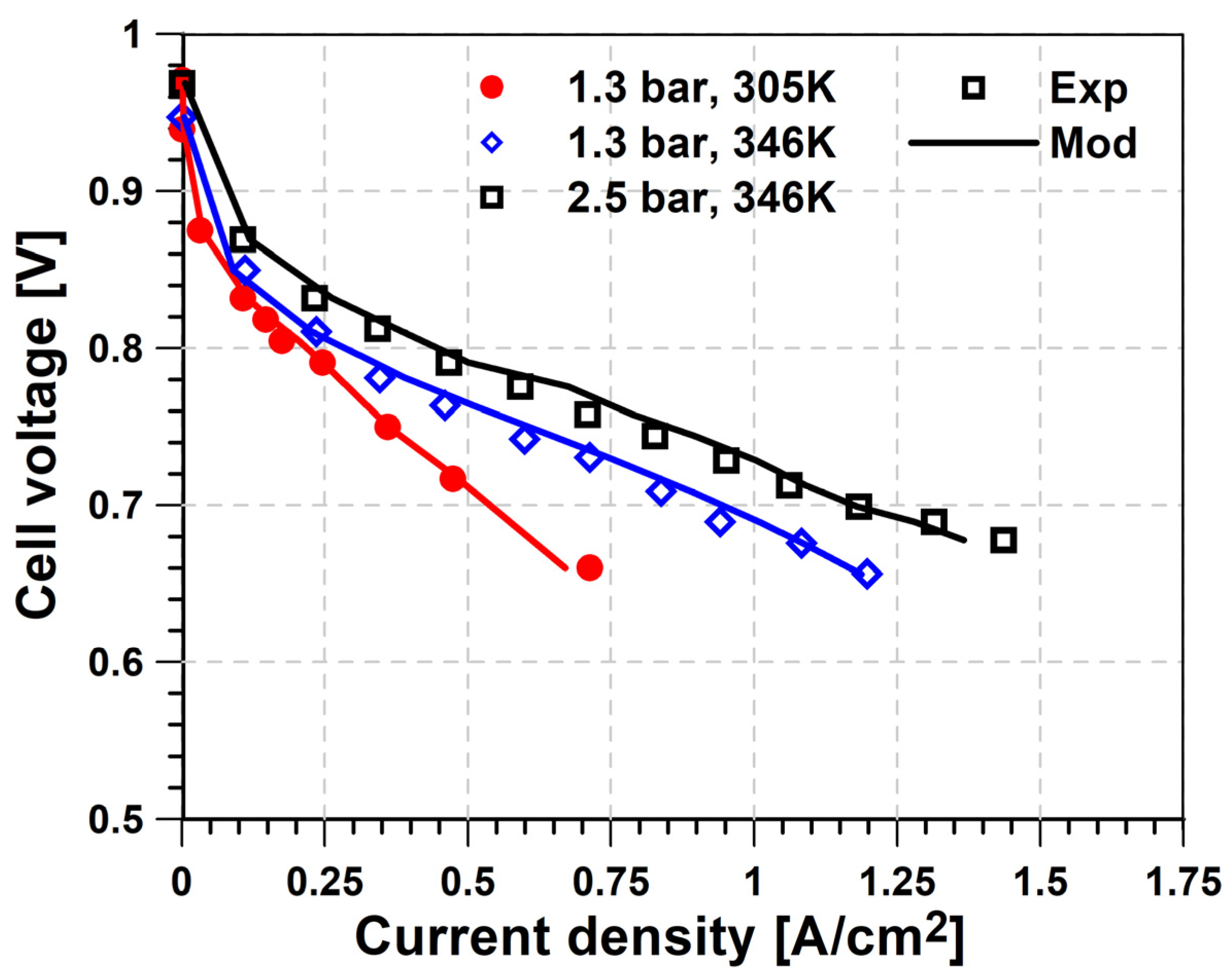
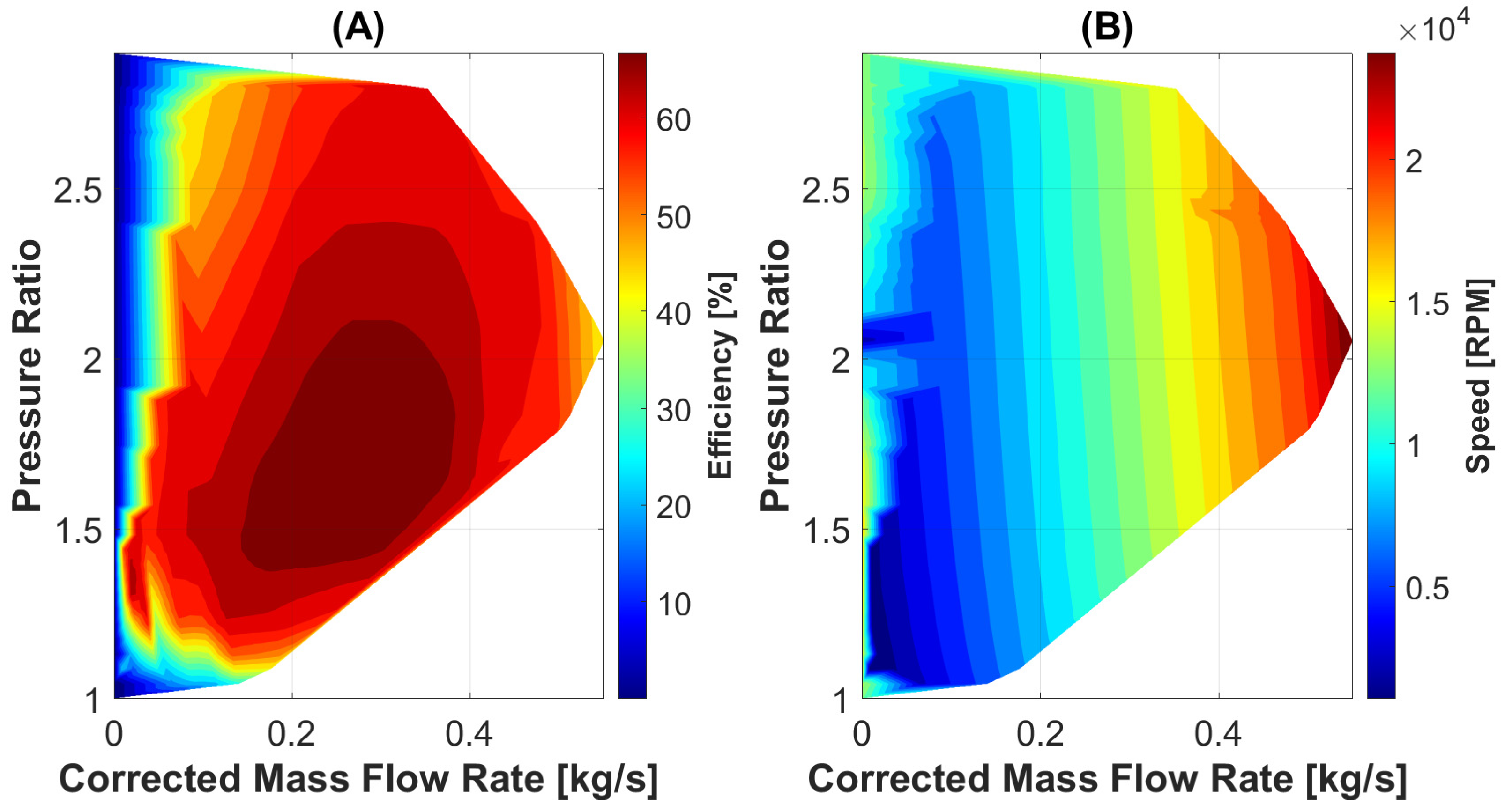
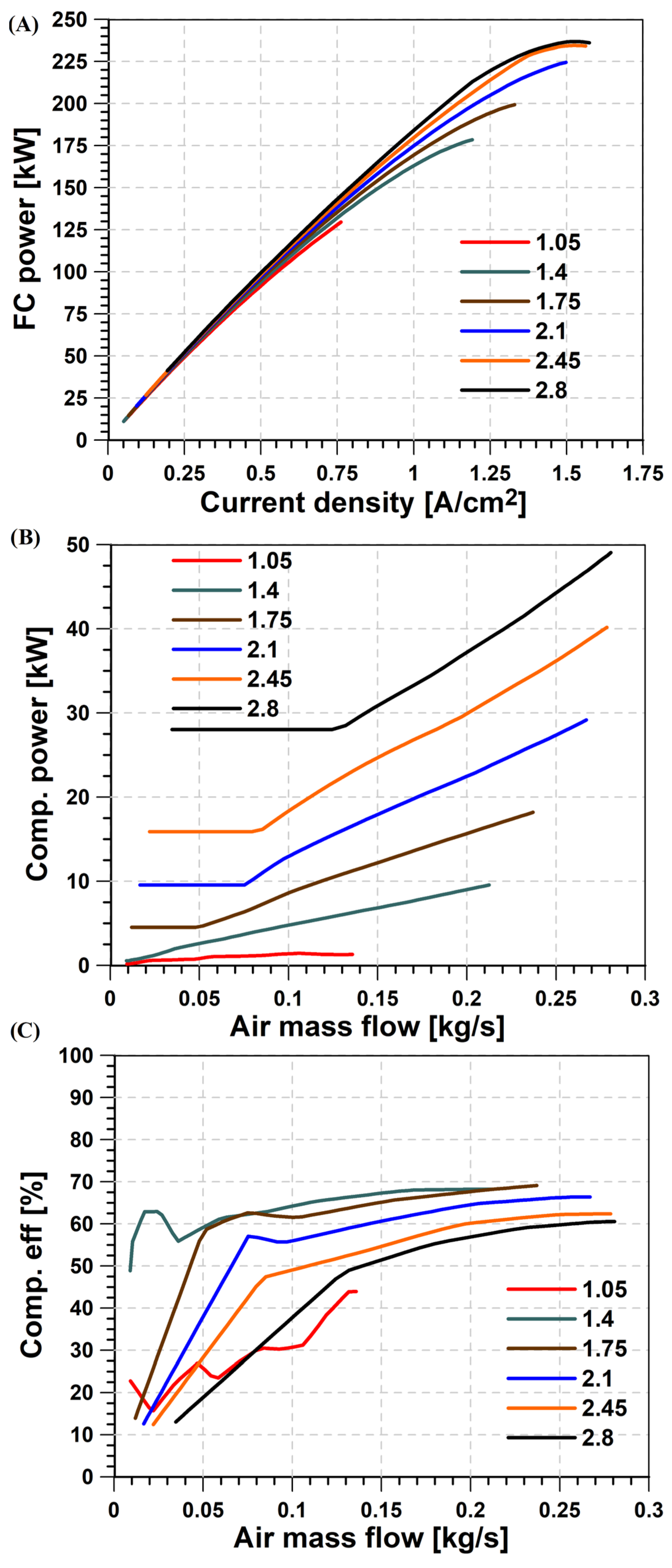
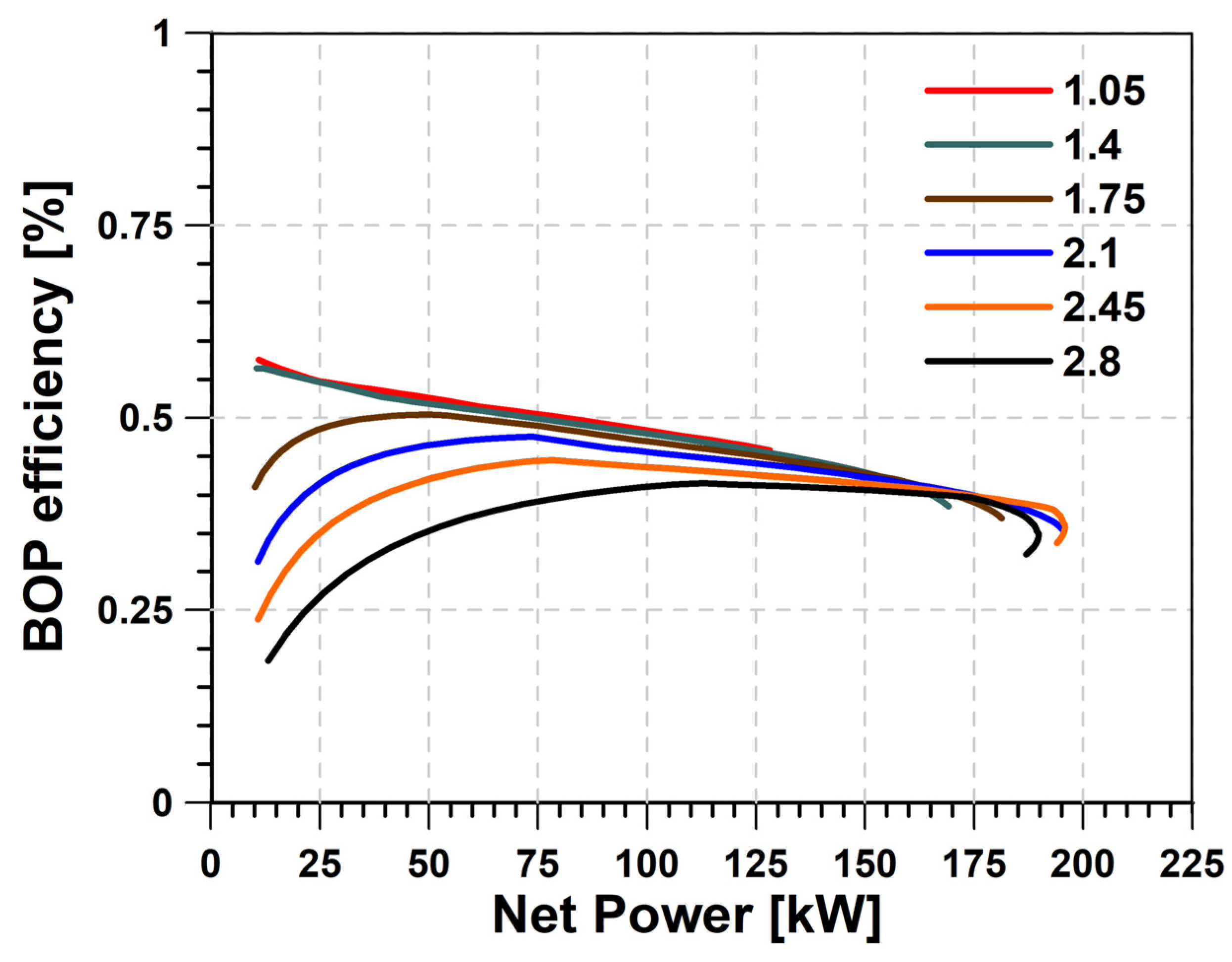
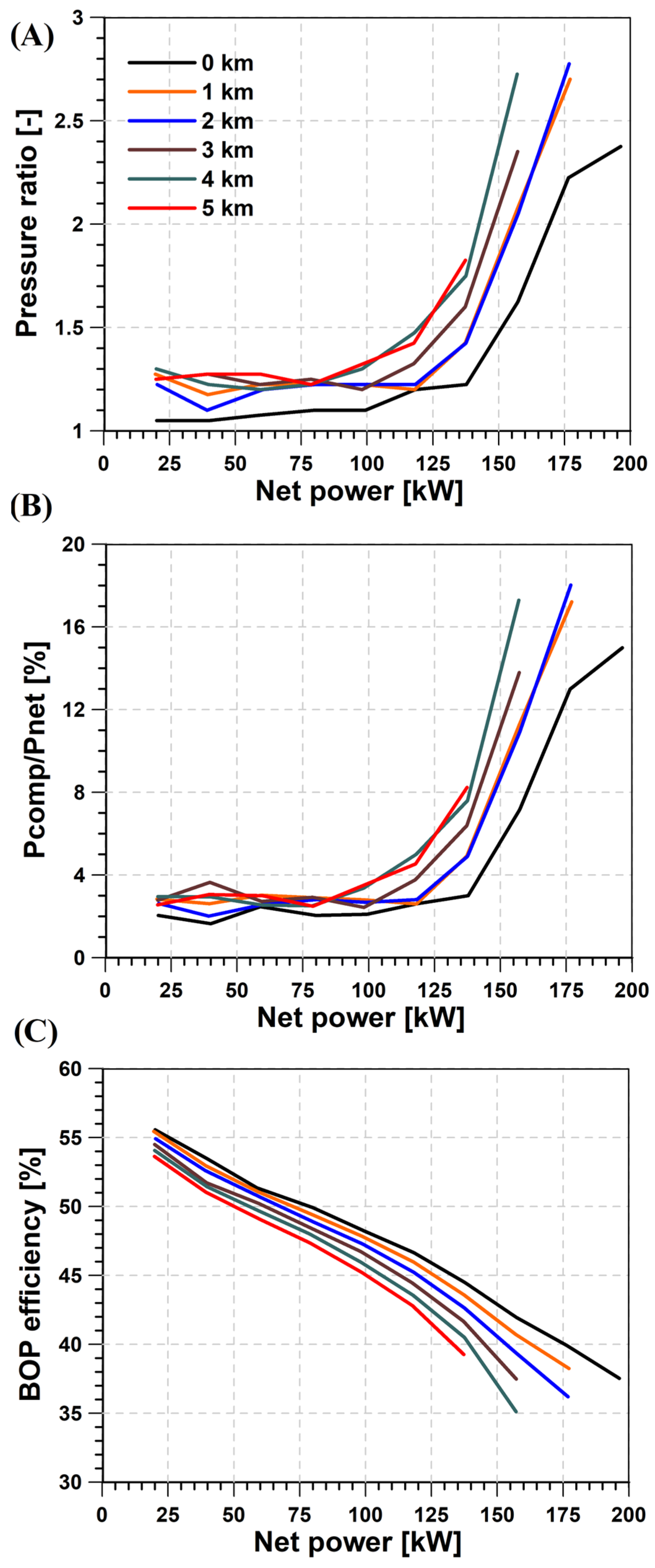
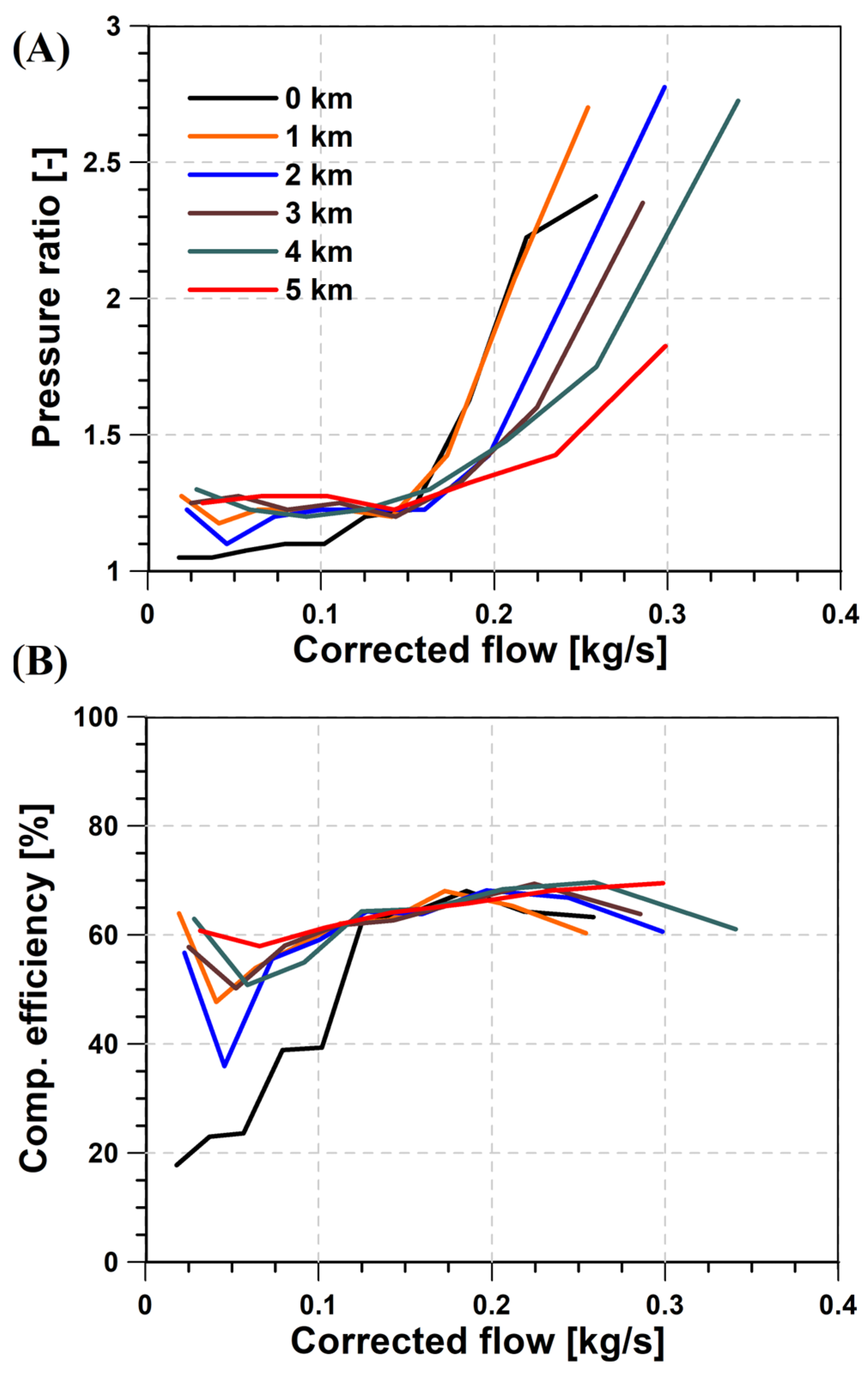
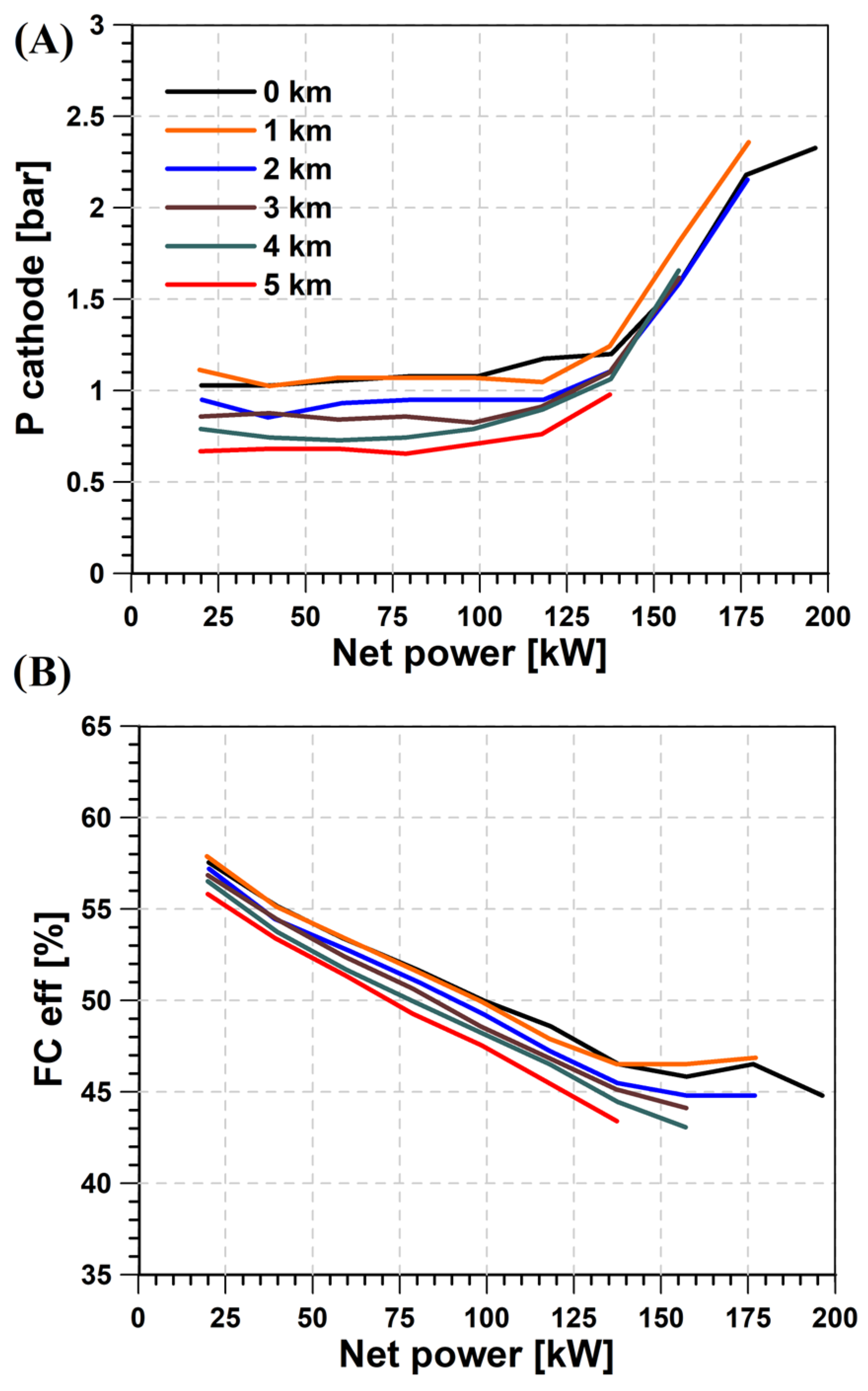
| Parameter | Value (Units) |
|---|---|
| Number of cells in stack | 1000 |
| Cell area | 280 cm2 |
| Membrane thickness | 125 µm |
| Gas diffusion layer (GDL) thickness | 160 µm |
| Catalytic layer (CL) thickness | 10 µm |
| Symmetry factor | 0.5 |
| Density of dry membrane | 2000 kg/m3 |
| Equivalent weight of dry membrane | 1.1 kg/mol |
Disclaimer/Publisher’s Note: The statements, opinions and data contained in all publications are solely those of the individual author(s) and contributor(s) and not of MDPI and/or the editor(s). MDPI and/or the editor(s) disclaim responsibility for any injury to people or property resulting from any ideas, methods, instructions or products referred to in the content. |
© 2025 by the authors. Licensee MDPI, Basel, Switzerland. This article is an open access article distributed under the terms and conditions of the Creative Commons Attribution (CC BY) license (https://creativecommons.org/licenses/by/4.0/).
Share and Cite
Piqueras, P.; de la Morena, J.; Sanchis, E.J.; Saadouni, I. An Analysis of the Altitude Impact on Roots Compressor Operation for a Fuel Cell System. Appl. Sci. 2025, 15, 5513. https://doi.org/10.3390/app15105513
Piqueras P, de la Morena J, Sanchis EJ, Saadouni I. An Analysis of the Altitude Impact on Roots Compressor Operation for a Fuel Cell System. Applied Sciences. 2025; 15(10):5513. https://doi.org/10.3390/app15105513
Chicago/Turabian StylePiqueras, Pedro, Joaquín de la Morena, Enrique José Sanchis, and Ibrahim Saadouni. 2025. "An Analysis of the Altitude Impact on Roots Compressor Operation for a Fuel Cell System" Applied Sciences 15, no. 10: 5513. https://doi.org/10.3390/app15105513
APA StylePiqueras, P., de la Morena, J., Sanchis, E. J., & Saadouni, I. (2025). An Analysis of the Altitude Impact on Roots Compressor Operation for a Fuel Cell System. Applied Sciences, 15(10), 5513. https://doi.org/10.3390/app15105513








